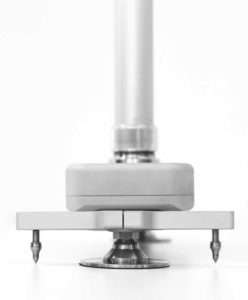Concrete chronicles: Achieving floor flatness and levelness

The ASTM E1155 measurement standard was developed for use with concrete finishing and confirming structural tolerances at the fixed point in time described above. Although referenced for use by other trades affected by FF/FL, its use is limited because data are made along defined lines of measurement and do not provide an overall evaluation of smoothness and evenness, which is better evaluated using straight edge measurements as described below.
Measuring flatness for flooring
In contrast to FF/FL testing for the concrete, the flooring industry employs the straight edge method for floor flatness. Straight edge measurements are indicated in the allowable deviation in plane over a specific distance, such as 6 mm (0.2 in.) deviation in 3 m (10 ft) span represented as 6 mm in 3 m (0.2 in. in 10 ft).
There are three primary challenges that result from the “inches and feet” straight edge method and the FF/FL method:
- This is no correlation between the FF/FL values and the inches in feet values.
- The straight-edge method does not require specific placement techniques for evaluation, leaving an unlimited amount of variability dictated solely by the tester.
- The time between Division 03 FF/FL testing and floor flatness straight edge testing are typically several months, up to a year apart.
- This means natural variations in flatness and levelness that occur as concrete cures and desiccates, decreases the initial values obtained within 72 hours obsolete.
- The initial values can change between 20 to 40 per cent as a minimum expectation or as much as 50 to 70 per cent, depending on how the concrete was cured, the FF/FL value specified, the weather conditions concrete experienced during construction, the type of concrete mix used, or the early application of loads on the finished concrete surfaces.
- An initial value of FF25/FL20 may decrease to FF15/FL17 in a worst-case scenario, making the concrete substrate unacceptable for most floor covering manufacturer’s straight edge measurement requirements.
When floors are measured for flatness, concrete has substantially cured. That curing alters the flatness profile of the concrete. While there is too much variability to define specific or typical values in flatness change over time, it is not uncommon for concrete to undergo these changes over a period of six to 12 months after placement. When the floor covering installer contractor initiates straight edge testing, the concrete flatness may not be indicative of the slab delivered by the concrete contractor within 72 hours after placement and will likely require some degree of wet or dry mechanical grinding to correct the natural decrease in floor flatness and levelness tolerances before they are called to site.
Uncommon ground
The use of two separate and incongruent measurement protocols in Division 03 and Division 09 often necessitates additional work to bridge the gap between them. This work generally results in change orders to grind or fill (lower and raise) elevations to an acceptable and uniform plane that meets the flooring specification requirements. Assigning the “fault” is difficult, and unforeseen costs and scope durations escalate as a result.







